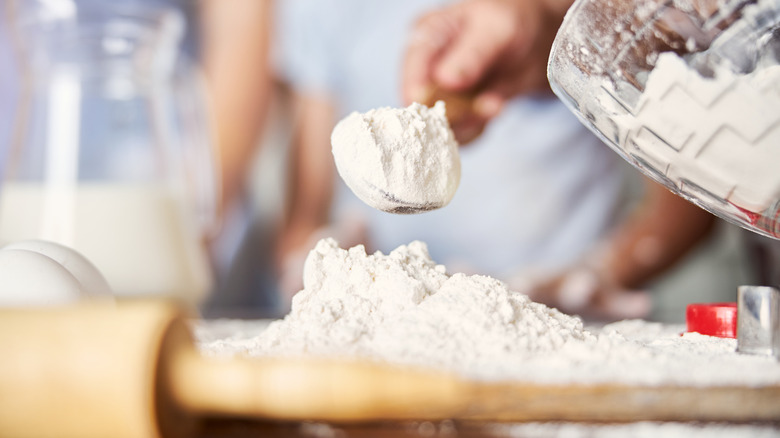The Difference Between Bleached And Unbleached Flour
Walking through the baking aisle at the grocery store presents a wide array of flours to choose from, including all-purpose, bread, and cake flours made from wheat, as well as a variety of gluten-free options. Making the decision of which flour to choose even more complex, many brands of wheat flour are labeled as either bleached or unbleached.
While both bleached and unbleached flours can be refined, in a procedure in which the bran and germ of the wheat kernel is stripped away (as opposed to whole wheat flour, which has the whole kernel and its nutrients left intact), the difference between the two flours is in their processing after milling.
Both flours are milled by grinding the wheat into small particulates, but you can't use freshly milled flour right away. Flour needs to undergo an aging process that helps with its functionality and flavor in baking. The difference between bleached and unbleached flour is in how the milled grains are aged: unbleached flour is aged naturally, which bleached flour is treated with chemical additives to speed up the aging process.
The aging step is key
Aging wheat flour helps with the elasticity and structural properties of the ingredient. Unbleached flour is aged naturally, with exposure to air for a period that lasts up to a few months. During this time, the flour matures, and the yellow hue of the wheat flour pales to a light white color.
This change in color is often a key indicator to assess whether unbleached flour has been aged. During the natural aging process, the proteins in flour are exposed to oxygen over time. When the flour is used in baking applications, the formation of gluten networks can occur, giving strength and body to many baked goods, including breads and muffins.
Alternatively, bleached flour was introduced in the U.S. in the early 1900s and allowed for manufacturers to produce more bags of flour and do so quickly, without the need to store and age the ingredient in-house. Bleached flour is treated with food additives and chemical agents, including potassium bromate, ascorbic acid, or nitrous oxide, to speed up the aging process from a few months to within one or two days. It is then bleached with chemicals, such as benzoyl peroxide or chlorine dioxide, to whiten the flour to mimic the whitening process that occurs when flour is aged naturally.
How to choose which flour to bake with
Deciding which flour to bake with is largely based on personal preference and could depend on baking application. Some bakers prefer to avoid food additives altogether, instead opting for the more natural option of unbleached flour (in fact, bleached and bromated flours are banned at health-conscious grocery stores such as Whole Foods Market), while others prefer to bake with bleached flour for its functional attributes.
As a general rule of thumb, bleached and unbleached flour can be used interchangeably in baking. There are, however, differences in the sensory aspects between the two flours. Bleaching flour affects the flavor, color, and particle size of the ingredient. Bleached flour has a brighter white color, finer granulation size, and a softer texture overall, while unbleached flour has a paler white color and a denser grain texture. Though the flavor differences are very subtle, some tasters have noted that bleached flour may have a slight acidic or bitter note from the flour's treatment.
Due to its softer texture and finer particle size, bleached flour has been known to have better water absorption qualities, which helps lead to fluffy pancakes and tender cakes with a finer crumb structure. The denser texture of unbleached flour makes it ideal for hearty yeast breads, muffins, and dinner rolls. However, when baking most sweet treats, such as dark chocolate and pistachio cookies, you can usually swap the two flour types without noticing much of a difference.


